A) 1, direct contact between the burner and the pan
B) 2, heating by thermal radiation through the air
C) 3, heated water expands and rises to the top of the pan and then cools and flows back down
D) 4, moving a pan of water away from the stove
F) B) and C)
Correct Answer

verified
Correct Answer
verified
Multiple Choice
A finely crystalline or glassy igneous texture indicates that:
A) there was a lot of gas in the magma
B) the rock cooled quickly
C) the rock broke apart as it flowed
D) the rock cooled slowly
E) the ash and pumice were hot and became compacted
G) A) and E)
Correct Answer

verified
Correct Answer
verified
Multiple Choice
The main cause of melting along subduction zones is the:
A) rise and decompression melting of mantle lithosphere
B) rise and decompression melting of mantle asthenosphere
C) melting of the subducting plate
D) release of water from the subducting plate
F) A) and D)
Correct Answer

verified
Correct Answer
verified
Multiple Choice
How does the addition of water cause melting?
A) it heats the rocks
B) it decreases the pressure on the rocks
C) it increases the temperature while decreasing the pressure
D) it changes the location of the liquid-solid boundary
F) A) and B)
Correct Answer

verified
Correct Answer
verified
Multiple Choice
When two plates are moving away from each other they are said to be: 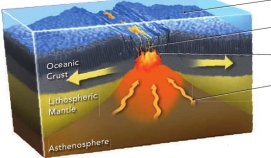
A) diverging
B) converging
C) remaining the same
E) A) and C)
Correct Answer

verified
Correct Answer
verified
Multiple Choice
Which of the following acts to keep a rock solid instead of melting) ?
A) an increase in temperature
B) an increase in the vibration within a lattice
C) an increase in confining pressure
D) none of these
F) A) and B)
Correct Answer

verified
Correct Answer
verified
Multiple Choice
Which of the following is true about igneous processes along oceanic divergent boundaries as shown in this figure? 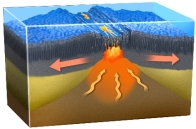
A) Oceanic crust moves toward the ridge in a conveyor-belt manner.
B) Most of the mantle is molten, not solid.
C) Solid asthenosphere rises as plates move apart.
D) Magma generated in the crust drips down into the mantle.
F) A) and B)
Correct Answer

verified
Correct Answer
verified
Multiple Choice
Which of the following were involved in bringing the deep batholithic rocks to the surface?
A) uplift of the rocks over tens of millions of years
B) a hot spot that formed a broad continental plateau
C) a continent-continent collision with Australia
D) the recent restarting of subduction beneath the area
F) B) and D)
Correct Answer

verified
Correct Answer
verified
Multiple Choice
Most subduction-derived magma never reaches the surface. However, what is formed if this type of magma reaches oceanic crust? 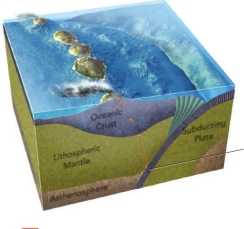
A) island arcs
B) mountain ranges
C) belts of calderas
E) None of the above
Correct Answer

verified
Correct Answer
verified
Multiple Choice
Which of the following processes has added heat to Earth's interior during or after its formation?
A) collision of asteroids and meteoroids with Earth
B) formation and sinking of masses of iron and nickel
C) radioactive decay
D) all of these
F) B) and C)
Correct Answer

verified
Correct Answer
verified
Multiple Choice
Which of the following changes in conditions could represent melting of continental crust from the introduction of a mafic magma? 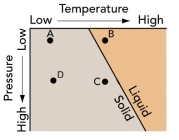
A) from A to B
B) from A to C
C) from A to D
D) from C to B
E) from B to D
G) C) and D)
Correct Answer

verified
Correct Answer
verified
Multiple Choice
A vesicular igneous texture indicates that:
A) there was a lot of gas in the magma
B) the rock cooled quickly
C) the rock broke apart as it flowed
D) the rock cooled slowly
E) the ash and pumice were hot and became compacted
G) A) and B)
Correct Answer

verified
Correct Answer
verified
Multiple Choice
The main way water gets into a subduction zone is by:
A) heating of the overlying continental crust
B) a decrease in pressure that causes melting
C) rain associated with eruptions in the island arc
D) seawater introduced into oceanic crust at the mid-ocean ridge, prior to subduction
E) all of these
G) C) and D)
Correct Answer

verified
Correct Answer
verified
Multiple Choice
Which of the letters shown on this figure would most likely have mafic basalt) magmas? 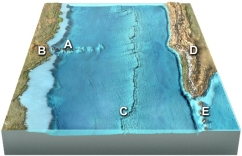
A) A and B
B) A and C
C) B and D
D) D and E
E) C and D
G) C) and E)
Correct Answer

verified
Correct Answer
verified
Multiple Choice
A magma chamber: 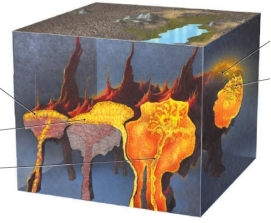
A) an underground body of molten rock
B) an above ground body of solid rock
C) an underground body of lava
E) A) and C)
Correct Answer

verified
Correct Answer
verified
Multiple Choice
Which of the following changes in conditions indicates heating of the rock? 
A) from A to B
B) from B to C
C) from C to D
D) from D to A
E) none of these
G) C) and D)
Correct Answer

verified
Correct Answer
verified
Multiple Choice
Which of the following rock photographs depicts a felsic igneous rock?
A) ![]()
B) ![]()
C) ![]()
D) ![]()
F) A) and B)
Correct Answer

verified
Correct Answer
verified
Multiple Choice
The igneous feature shown in this figure is a: 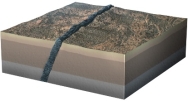
A) dike
B) sill
C) volcanic neck
D) laccolith
F) A) and D)
Correct Answer

verified
Correct Answer
verified
Multiple Choice
Minerals crystallize:
A) in the opposite order they melt
B) in the same order they melt
D) undefined
Correct Answer

verified
Correct Answer
verified
Multiple Choice
The site on the accompanying figure that would most likely form a rock that is glassy with no volcanic ash is: 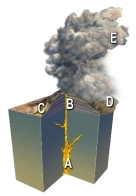
A) A
B) B
C) C
D) D
E) E
G) C) and E)
Correct Answer

verified
Correct Answer
verified
Showing 101 - 120 of 147
Related Exams